|
Navigation
LakesnWoods.com
Home
Page
Contact Us
Privacy
Minnesota Gift Guide
Swatara Guide:
Location
Geography
Demographics
History
Government
Post Office
News
Weather
Street Map
Events
Attractions
Recreation
Lakes
Health Care
Schools
Churches
Media
Motels
Resorts
Campgrounds
Businesses
Aerial Photo
Topographic Map © 2004-2025
LakesnWoods LLC
All Rights Reserved
DCMA, Defamation, Copyright and Trademark Infingement Policy
|
WANTED! Do you have photos, historical accounts or
other items pertaining to the Swatara area? Would you like to
share this historical information with the world?
LakesnWoods.com would like to publish your Swatara photos
(current or historical) or historical accounts on this website.
Original materials can be returned and your privacy will be
respected.
Contact us |
|
Swatara Minnesota
History
"BOYDVILLE BECOMES SWATARA"
Excerpt
from "Beyond the Circle"
by Leo Trunt
Very little is known about the
inhabitants of the Swatara area before white settlers came. The U. S.
government surveyors make note of Indian activity around Moose Lake and
the presence of a trail that the Indians used in their travels. The
trail basically went north and south from Aitkin to Hill Lake and on to
Pokegama Lake. Early accounts of just who these Indian families were and
how long they had been living there are conflicting. Some infer that
they had always been there and others say they had recently moved in.
One account is recorded as: "Just below the Spur lived the Chippewa
Indians, most of them relatives and descendants of Tom Skinaway. Many
are under the impression they were the first people up here, but not so.
These Indians moved in after Boyd had his ranch and were hired to cut
hay for him to be used in his logging operations. He brought them up
from Mille Lacs Lake Reservation. They set up their teepees among the
birch trees there. The men cut hay from surrounding meadows with scythes
and slid the hay on two poles into stacks.
They must have done a satisfactory
job as they were there many years. Another reason they came was the
plentiful supply of birch bark available that they used in making
canoes. The women were the ones most adept at this and they made quite a
few each year. They were well made and were sold at fairly good prices.
Mrs. Tom Skinaway was widely known for her knowledge of a dozen
different kinds of herbs and roots that she collected and
processed....Some of the men worked in the woods and were good drivers
on the spring drives. Just below their camp was another small graveyard
that they used, so it must have been the first cemetery. It had been
used by other Indians and then Tom Skinaway's people. This camp was used
until the early thirties when many went back to Mille Lacs or scattered
to other parts. After Tom passed away none lived here." (A century of
Pioneering Pioneers, page 61--Frank and Jennie Hutz interview)
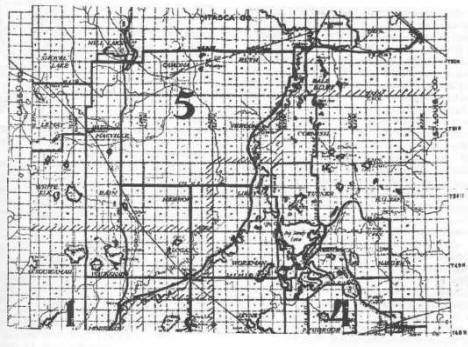
Early Map of Northern Aitkin County, 1920 -
Courtesy of Aitkin County Land Department
In the early years before the railroad came, the Swatara area was a
total wilderness. Logging was the main activity from 1870 to 1910. There
were numerous logging companies during this time period that were using
the Willow and Moose Rivers for the driving of logs. This was the
easiest way to transport the logs to markets in Minneapolis, which was
then a big sawmill town. Fred Blair, James Boyd and others were actively
engaged in the logging business during that time period.
James "Jim" Boyd had come from Canada in 1878. He spent some time
working at a mill in Minneapolis and then moved to Aitkin in 1882. It
was about that time when Jim became employed by the U. S. Postal Service
to carry mail over the old Indian trail from Aitkin to Grand Rapids. Jim
was employed by D. J. Knox at his sawmill, and then he went into the
logging business with his partner Mr. McMonagle. Jim bought his ranch in
1898, which was located south of the Moose River about a mile and a half
from Swatara. He built a livery stable and for some years "Boyd's Ranch"
was a popular stopping place for weary travelers. Other stopping places
in the area were the Allen Ranch, the Polly Ranch, the Waldeck Ranch and
Welsh's Ranch. (Ibid, Page 50--Carlton Bailey interview)
Jim became postmaster for the area on September 14, 1903. Jim had
petitioned the post office to be called "Boydville". The postal service
apparently would not accept the name and so they changed it to
"Swatara." The name was apparently derived from Swatara Township,
Pennsylvania. It is not known where the name originated. "One source has
stated the meaning as 'between two rivers' and another 'three lights'. A
search of Indian languages sheds no light on the above two meanings.
(Per letter written by Harvey F. Trepanier dated 5/15/1975) In any
event, the name seems appropriate as the village lies between two
rivers. Jim continued as such until April 29, 1908. Why he gave up the
post is not known. On February 15, 1911 Art Heath resurrected the post
office at the town site of Swatara. Jim also was the state census taker
for Macville Township in 1905. Among the various inhabitants of the
township, he noted that J. Shriver was the local blacksmith.
A. H. (Ace) Young came to Aitkin in 1901 and settled on his homestead on
the east side of Lake McKenney in 1909. In 1910 after the Soo Line was
built, Ace joined Jim Boyd in a logging operation at "Spur 296" or "Boyd
and Young's Spur." This was just south of Swatara about a mile and a
half down the Soo towards Bain. Carlton Bailey relates the following.
".....Boyd and Young had a lumber mill, a shingle mill and a planing
mill at the spur. They had several logging camps which included the
following locations: At the spur, at a place southeast of Boyd's ranch,
near the Polly Ranch, in Swatara, and a sawmill with a shingle mill in
the Lake Edna area....." (A century of Pioneering Pioneers, page
50--Carlton Bailey interview)
The Aitkin Age also tells of Boyd and Young's Spur: "They are running
their (shingle) mill night and day and cutting 36,000 shingles every
twenty-four hours. They also have a crew of thirty-five men in the woods
getting out cedar, etc., and the amount of cedar they have strung along
Moose River is amazing." (Aitkin Independent Age--March 9, 1910)
Besides the logging operation, they had quite a large warehouse and also
a store where they supplied the needs of the community and their quite
extensive logging operations. "They carried on at this location until
1916, when they moved in Swatara after having built what was known as
Boyd and Young's 'Big Store'. (A Century of Pioneering Pioneers, pages
50-51)
"We hauled logs to Boyd and Young's Spur where they had a mill and also
a building. (It was) quite a large one that had an office in one end
(which) was the only part heated. The main part was a huge grocery and
hardware warehouse. You would come into the office and tell Ace Young
what you wanted and he'd take you order and then put on his coat, cap
and mittens and load up what you wanted. Everything was sold in quantity
and they didn't even have a scale. Flour was sold by the 100 pound sack
and the same for sugar. All other items by the box or the case." (Ibid,
page 8--Alphonso Olds interview)

Boyd and Young Letterhead
This store was to be of considerable importance in the early life of the
community. "....Boyd and Young erected a large 60 by 24 two story
building in Swatara. (It was) a two story building with the first story
used for grocery and hardware and the second story was used as a
community hall. For many years this was the center of all community
activities. It served on Saturday nights as a dance hall, on Sunday
mornings and afternoons as a Sunday school and for church services. Boyd
and Young ran this business from 1916 to 1919 when they sold out to the
Heath brothers." (Ibid, page 52) Boyd and Young still had some business
going on as late as 1920, when they sold dynamite to the town of Lemay.
(Town of Lemay claim, Aitkin County Land Dept. records, dated 9/20/1920)
Perhaps the most important event in the early history of the Swatara
area came in 1910 when the Soo Line Railroad was built through town. An
enormous boost was given the economy of the small town, as there were
many railroaders who needed food, clothing and other supplies. The
railroad, along with the nearby logging operations and the new
homesteads being built, added to the town's vitality.
The railroad constructed a number of facilities in town. In October
1910, the section house and a well were built. March of 1911 saw a
passenger platform go in. A two stall outhouse was built in September of
1912. In November of that same year, the depot was put in. In August of
1915, a train order signal was placed at Swatara. An addition to the
depot and a depot platform were built in September of 1917. A stock
yard, shed and feed racks were installed in May of 1921. The Soo
Railroad had big plans for Swatara.
By 1915, the Soo Line put on Frank Langer as a full time depot agent.
Since that time the agents have been George Reynolds, Ted Mount,
Clarence (Swede) Nelson, Don Dalton and Gilio Baldovin. The section
foreman from 1934 to about 1959 was Oscar Halvorson.
The 1910 census sheds some light on the community. Forty-eight men were
in town working on the railroad as the census was taken. Many of those
men were of Yugoslavian nationality. The dredging crews were accounted
for, and they had ten employees listed. The rest were of various
occupations such as farmer, laborer, carpenter, etc. Thomas Donnelly had
a sawmill and was making lumber, lath and shingles.
Another early settler was Pete McGee. "....before the turn of the
century Pete McGee worked in the mills of Aitkin during the summer
season, and in the fall headed north with other lumber jacks to take up
jobs in the various logging camps....For years he followed the log
drives on the Big Willow, the Moose and on down the Mississippi....Pete
filed a claim to a homestead that was where Swatara later came to be
settled. Because of this, Pete was called "The Father of Swatara"....In
1912 Earl Heath and Pete got the contract to build the second school up
on the hill....This was quite a step from the first tar paper school
near the section house." (A Century of Pioneering Pioneers, page 67)
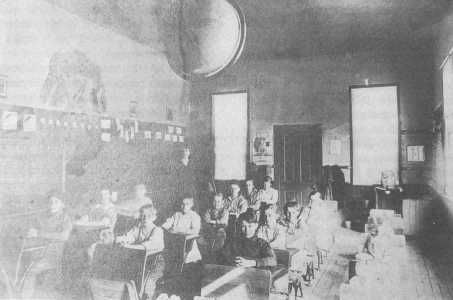
The Old Wooden Swatara School, 1917 -
Courtesy of Truman and Hazel Biskey
Myrtle Trepanier Jewett was the first white child born in the Swatara
community. (Per interview with Betty Trepanier on 9/30/1996) It was soon
apparent that schools would be of great importance to the town. The
first school at Swatara was built at the time the Soo Line came to town.
It was nothing more than a tar paper shack that had been hurriedly
constructed, for the influx of people and their children made it a
paramount need for the town. This building was not sufficient, and so in
1912, the second school was built. About this time other schools were
being built around the countryside. The schools were placed about two to
three miles apart, as that was about all the children could be expected
to walk. Frank and Effie Trepanier came to Swatara with the railroad.
Frank worked with the construction crew building the railroad through
town, while Effie was cooking for the crew. In the fall of 1910, Frank
and Effie decided to go into the grocery business at Swatara. "Frank
built a 10 by 16 foot store with a lean-to at the rear. Before it was
completed he ordered his initial supply of groceries from Duluth and did
his first business from a boxcar....The following year a new store was
erected. Frank expanded his store building when he felt a hotel was
needed in Swatara....He discontinued the hotel in 1930." (A Century of
Pioneering Pioneers, page 33) Frank also had a pool hall in the basement
of the store.
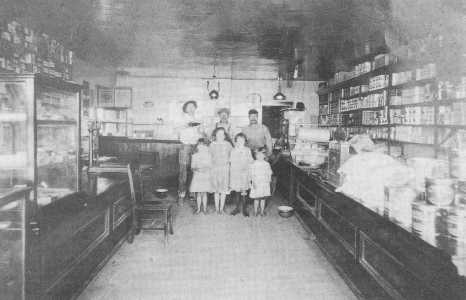
Inside the Trepanier’s General Store, 1924 -
Courtesy of Truman and Hazel Biskey
Not to be outdone, the Heath Brothers came to Swatara as soon as the Soo
Line came to town. "Sometime in 1910, Art and Nannie (Heath) went to
Swatara to start a store there....Earl came in early 1911. Art and his
other brother Harvey cruised timber and Art ran their crews that they
had in their logging operations. Earl ran the store, bought timber,
(did) various kinds of scaling and counting in the business....Art also
farmed near Swatara and did considerable haying to supply their teams at
their camps. His operations at farming included raising potatoes....
From 1917-20 The Heath brothers logged at Martin's Spur on the Hill City
Railroad. In 1920, the brothers bought the lath mill at Boyd and Young's
Spur near Swatara. It burned in 1924 but the Heaths salvaged some of it,
rebuilt it and moved to Hill City where they sawed lath for over a year.
Then they moved to Washburn and for several years operated there....Art
managed the mill living in the camp with his wife cooking....Earl ran
the store and post office (back at Swatara) which he took over from Art
in 1915. He remained postmaster until 1951." (Ibid, pages 74-77--Earl
Heath interview) The Heaths ran the lath mill at Washburn until
Alexander (Sander) Olson bought the mill in 1928.
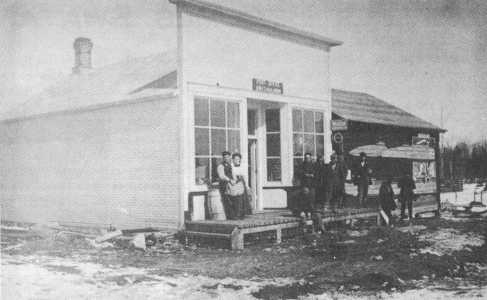
Heath Brothers Store & Post Office, 1911 -
Courtesy of Herman Nelson via Karen Bailey
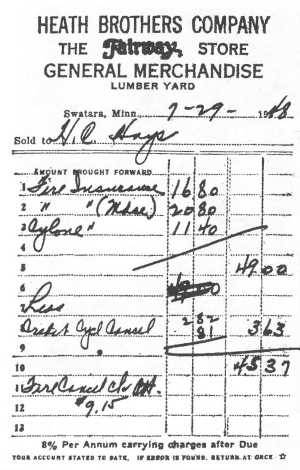
Heath Brothers Company Receipt -
Courtesy Ken Gobel
Besides the store, the Heath Brothers also did some undertaking business
and had a number of caskets laying around in back of the store. The
Heaths also operated a lumber yard in the late twenties. "Messrs.
Kennedy and Jewell have finished the work on Heath Bros. new lumber yard
and a portion of the new stock has been put in the sheds. There are two
large long sheds facing a driveway between them. In the front of the
east shed is a moisture proof cement and plaster room of two thicknesses
of lumber with paper between. On the west side corresponding is another
room for wall board etc. A car load of western shingles and flooring has
been unloaded as well as a car of cement and wall board and a stock will
be built up from time to time. This marks another step in Swatara's
progress." (Hill City News--October 11, 1927)
An early account sheds some light on the happenings at Swatara. "All
report having had a good time at the dance at George Frank's on Saturday
evening....A car load of 2,111 Christmas trees has been loaded by the
Cook Bros. and is now ready for shipment to Minneapolis....A bear was
killed by an Indian a few days ago, about two miles from Swatara. The
owner being very kind hearted, shared the prize with his friends...The
Heath Bros. are moving their old store building onto the lot adjoining
their new store and will remodel it so as to use it for a feed and flour
warehouse." (Aitkin Independent Age--December 9, 1911)
Pat McGlade built a hotel in 1912. He planned to make a good living at
the hotel but it didn't perform as he had hoped. He struggled there for
a few years until he sold out.
In 1913, State Highway 35 was built through town on the way to Shovel
Lake and Hill City.
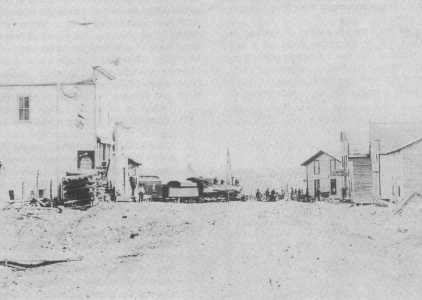
Swatara Main Street, 1917 - Building
on the left is Heath Brothers Store & Swatara Post Office -
Courtesy of Truman and Hazel Biskey
As Swatara got organized it appeared that building lots were being sold
by "meets and bounds" methods, a simple way of selling land without the
use of a survey. It got confusing and disputes erupted. It got so bad
that on October 15, 1917, the Aitkin County Auditor forced a survey and
platting of the bustling community. (Plat of Swatara, Aitkin County
Recorders Office) From this point on the residents and merchants would
have positive proof of where their respective property lines were.
Early land speculators worked hard to entice people to come to the
Swatara area. The Willow River Land Company and McNamara and Murphy,
Inc. were large concerns selling land to farmers.
In the teens, telephone systems were set up in the various townships.
The townships were taking the lead in this new technology. Their main
emphasis to start with was to provide a "Fire Call System" to warn
neighbors when there was a fire and a call for help was needed. These
were ground systems that used a primitive grounding method to operate
the lines. In time, more up to date systems were put in place that gave
much better reception. Systems were put in Bain, Lemay, Shovel Lake and
Macville Townships. The Swatara system was built in 1913. Mr. Bloyer was
the first manager. (A Century of Pioneering Pioneers, page 75) The
central office was moved a few times, and for a time was in the same
building that Mrs. Frank Olds had her restaurant. Rose Seymore was the
central operator at Swatara until the local system was discontinued. The
area phone systems consolidated, and there were basically two local
systems operating out of Swatara and Hill City. Eventually, the Swatara
system was sold to the Hill City Telephone Company when Mr. Hale was the
manager. In 1933, Hale sold out to Frank Dichtel, who updated all the
lines. Some people near Shovel Lake got service from Remer.
Baseball may be the national pastime, but in Swatara baseball is king.
The first team was organized in 1912. Bill Boyd and Earl Heath were the
first promoters of the game. Ace young was the manager during the early
twenties. There were teams at Palisade, Haypoint, Shovel Lake and Hill
City. Art Heath was the first scorekeeper, and Earl Heath was generally
picked as the head scorekeeper during the thirties and later years. He
always did a neat and complete job down to the finest detail.
Occasionally, Swatara would join forces with Shovel Lake or Haypoint and
play teams from Hill City or McGregor. Even the girls got in the act,
and in the thirties, a league was formed for them to play softball. To
this day, softball and baseball reign supreme in Swatara. At the annual
"Old Timers" July Picnic, baseball is still played. Old and young go to
bat. Even if baseball was no longer considered as the national past
time, it would still be played and loved at Swatara. Clyde Ballpark was
named after Clyde Stansberry. He was "Mr. Baseball." Clyde followed all
aspects of the game. He just couldn't get enough of it. (Per interview
with Truman and Hazel Biskey on 12/22/1995)

Swatara Baseball Team, 1948 - Back
Row: Leo Butterfield, Darrell Gillson, George Bailey Jr., Mossy Holm,
George Trepanier, Duane Landrus, John Holm, Herbert Stansberry.
Front: William Trepanier, Gordon Goble, Walter Gillson, Hamm Mills,
Melvin Kingsley, Courtesy of Evelyn Hilton
The farmers were doing so well that in 1914, Harry Baldwin shipped a
carload of cattle to the stockyards.
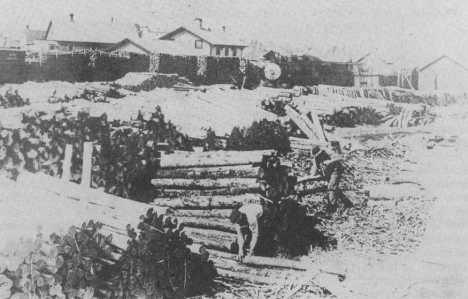
Stockyards Near the Depot at Swatara, 1920
Depot is in the background center Courtesy of Truman and Hazel
Biskey
Frank Lemay lived in the township to the west of Swatara. He was a
farmer and also did well drilling for others. When the township was
organized, it was named after him. It is not known who the founding
fathers of Lemay Township were, but perhaps Frank Lemay had a hand in
it. The township was organized on April 17, 1912. In 1913, the township
people elected Frank Lemay, Ray Stratton and Ace Young as its board of
supervisors. George Franks was elected town clerk with John Buttrick
becoming the treasurer and Ralph McNeil the assessor. George Harrington
was voted in as the Justice of the Peace and Frank Lemay was picked as
the local constable. (Lemay Statement of Canvass, Aitkin County Land
Department records dated 3/11/1913) By 1916, George Harrington, George
Franks and Roy Stratton had taken on the job of election judges for the
township elections. Lemay Township was an active government. They had a
township hall where meetings and dances were held. They also established
a township telephone system. "We are in receipt of your letter of August
19th advising us that four of the Kellogg wall telephones which we
shipped you last spring were equipped with 2000 ohm ringers instead of
1600 ohm ringers as was desired. We take it that you wish the 2000 ohm
ringers to be replaced...." (See correspondence of Northwestern Electric
Equipment Co., Aitkin Co. Land Dept. records dated 8/22/1919)
Road building became a major effort for the township supervisors and a
number of roads were built. In those days, a road poll tax was sometimes
placed on the local residents. This was used for the upkeep or
construction of roads. It was not unlike assessments made today by
cities. Back then you could pay the assessment of "Poll Tax" in cash or
you could work it off by helping with your labor to fix the road. Most
people chose to work it off. The township hired many different people
for various tasks and so spread back much of the taxes levied.
Lemay Township citizens were also active in taking care of whatever the
needs of its people were. They worked cooperatively with the other
communities. "Last Monday a number of men were called from Shovel Lake
and Swatara to help fight a fire which broke out near the town hall (Lemay)
and swept northward." (Aitkin Age--May 25, 1930) Dances and parties were
held at the hall. "Many people from Swatara attended the masquerade at
the Lemay town hall last Saturday night. Mrs. W. B. Russell of Shovel
Lake won the ladies first prize and Archie O'Brien won the men's first
prize. There was a large crowd and everyone seemed to be having a good
time." (Hill City News--November 9, 1922)
Another resident in Lemay Township was James Vellas. Some folks referred
to him as Jimmy the Greek. Jim was a farmer and a good mechanic. "James
Vellas is overhauling his Waterloo Boy tracktor (sic) this week. Jimmy
says that he will 'educate' it to pull stumps and do all sorts of
extraordinary things when he gets it to running." (Ibid--October 25,
1927) Jim liked to sell or peddle goods wherever the opportunity arose.
He would peddle produce, chickens, calves etc. as far as the Iron Range
or even St. Paul. Jim was a good musician and played the banjo at
various dances. (Per letter from Anastasia Vellas dated January 30,
1997)
Newlon Harrington was well known for his abilities as a photographer.
Some of his photos exist to this day, and show his talent as a free
lance photographer.
Lemay Township hit upon tough times during the depression and so the
town was dissolved on December 6, 1932.
Swatara was in a zone of alcohol prohibition even before the entire
country went that route. It had something to do with the Indian treaties
where certain areas of the state were declared off-limits to
intoxicating liquors. This was supposed to help Native Americans abstain
from the effects of alcohol. However, bootleg liquor somehow found its
way into the area. One bootlegger from Hill City had a bad experience in
trying to ply his trade. "Hill City's pet bootlegger had a little
trouble at Swatara the other day. He arrived there with his trunk load
of booze in his usual manner, but when he got ready to start for Hill
City a couple of strangers were sitting on the trunk and he was afraid
they might be government agents so considered it a wise plan to leave
the trunk and come to Hill City to see what the prospects were for
business. Everything was lovely so he hiked back to Swatara for his
hundred quarts of fusil oil and found that thriving burg in the midst of
a drunken orgy. It was a regular old fashioned rousing time with all the
trimmings, including several fights. But his trunk load of dope had
disappeared. Some Swataraite with a keen nose, had evidently smelt out
the contents and, as it was contraband of war, felt justified in
treating the town. This booze agent has done quite a business in Hill
City, although we are informed that the dope he peddled out at high
grade prices, would scarcely pass under the pure food and drug act.
Maybe he will come again, but the chances are that he is disgusted with
a country where they are so unlawful as to steal a persons stock in
trade. (Grand Rapids Herald-Review-May 17, 1916)
There was a Catholic group in Swatara which decided to construct a
church. In 1916, that became a reality. "The dedication of the new
Immaculate Conception Catholic Church of Swatara will take place
tomorrow afternoon at 2 o'clock. A good program is to be rendered
including several selections by the well known Knuppel
orchestra..."Aitkin Independent Age--September 2, 1916) This church
operated until 1929 when a newer building was erected. Services were
then held in St. James Church (the name was changed) until 1993 when it
closed.
Another group formed the Swatara Methodist Church. A ladies aid group
organized on February 22, 1922. Services were held in the Heath Hall in
early 1925. Rev. Arthur Cartwright of Hill City helped organize the
Swatara Society on April 12, 1925. The charter members were Mrs. A.
Heath, Mrs. E. Heath, Mrs. Rose Seymour, Mrs. Dick Ravnes, and Mrs.
George Franks.
On April 26, 1925, the Swatara Methodist Episcopal Church was organized.
Fund-raisers ensued for the construction of a church building. With a
lot of voluntary labor, the church was completed in late 1933. The
Reverend Elsie Hartman dedicated the church on December 3, 1933. Elsie
relates, "The following members were elected as trustees: A. A. Heath,
E. E. Heath, John Biskey, Glen Baty and John Gulden. I baptized a total
of 179 in Swatara during the twelve years I was there." (Per Herman
Nelson notes--A Century of Pioneering Pioneers) Finances were always a
problem, but somehow the church continued on. The church served the
community for many years.
Donald Wilcox established a rural bus service in 1919. "Mr. Donald
Wilcox has decided to establish a bus line between Aitkin and Swatara
and will begin business on April 1st, or as soon thereafter as the roads
will permit. Evidently Mr. Wilcox has sensed the extent to which
automobile transportation will grow when the concrete roads become a
fact, and he wishes to get in on the ground floor." (Aitkin
Republican–March 27, 1919) It is not known how long Mr. Wilcox's
business thrived, but it served the community for a time.

McFeeters Bus Service Traveled from Swatara to
Hill City - Courtesy of Bill and Esther Lange
In 1920, the census taker made several notes about the Swatara
community. Roscoe Reynolds, Earl and Art Heath, George Hunt, and Frank
Trepanier were retail grocery merchants. Lewis Royer was the hotel
proprietor, while Ed Foley was the livery stable manager. Boyd and Young
were contractors for ties and posts. George Reynolds was the railway
agent, and Frank Hutze had a dray line business. Arthur Harvey was an
automobile mechanic. Other store owners through the years were John
Brennick, Frank Zealand, the Mushel Brothers, W. J. Webb, Frank Olds, D.
B. Heath, Louis Hartman and Trepanier (George) and Jewett (Leo). There
were garages run by the Ravness Brothers, Dewey Fenstemaker, J. R.
Gillson and the Nelson Brothers. The lone service station was run by
Roscoe Reynolds, then Louis Hartman, John Knapp, and finally by the
Nelson Brothers. (A Century of Pioneering Pioneers, pages 79-80)
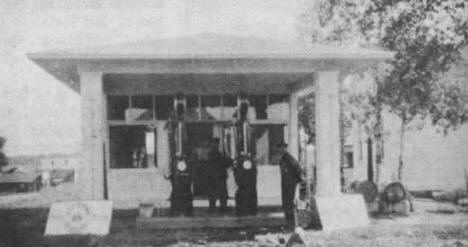
Roscoe Reynold’s Station, 1921 -
Courtesy Herman Nelson via Karen Bailey
"Not far from Frank Lemay's home was a school house, one of the first in
those parts, known as Boyd's School. The tote road then went on to what
was later the Newlon Harrington place and then on to John Gulden's
place."(A Century of Pioneering Pioneers, page 8--Alphonso Olds
interview) It is not known if the Boyd School was a separate school or
considered the same as the Green School. After the consolidation of
schools in 1921, the Boyd School may have been converted into the Lemay
Township Hall. The hall was located on the southeast corner of the road
coming from Swatara now known as Huff's Corner. The Green School, which
was built in 1909, was later called the Harrington School. (Ibid, page
55) George Harrington and his family lived nearby, and so people
recognized the school by that name.
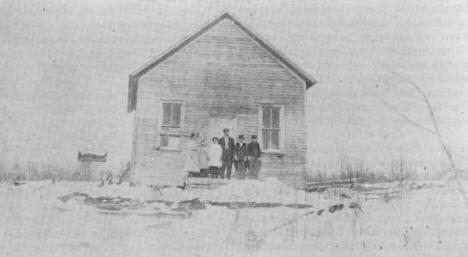
Harrington School, 1911 - Courtesy of
Stacey Vellas
In 1921, the new consolidated school was built and many of the rural
schools were closed. The Harrington School in Lemay Township, the Olds
School in White Elk Township and the Haypoint School were closed, and
the children were bussed to the Swatara School.
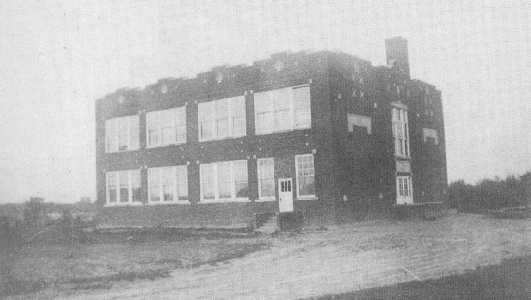
Swatara Consolidated School - Courtesy
of Kit and Evelyn Butterfield
There were a lot of misgivings when the move to consolidate the rural
schools came. People liked the touch of a local one room school.
Nevertheless, the new Swatara School was built. "This new building at
Swatara was of brick and concrete construction, it had two stories with
a half basement under it. It had four rooms with a room for a library
and an auditorium on the first floor. At the beginning all four rooms
were occupied and had four teachers. The original enrollment was about
135....When this school was first built it was the ultimate as schools
go. It was complete with showers and the most modern rest room and
playground equipment....No more scrubbing in a wash tub in the kitchen
on Saturday nights...." (Ibid, pages 55-56) The new school had its own
power plant run by a gasoline engine in the basement. Besides pulling a
generator, the engine also circulated air around the building. The
engine's exhaust gases fumes went up a gas pipe inside the furnace
chimney, which also took care of the engine noise. The school's furnace
was built as a wood or coal burner and used up to four foot cord wood.
Walking to school was now replaced by the convenience of riding the bus.
"....These kids rode to school in five school buses over many routes.
The original conveyances were Reo Speed Wagons with wooden Wayne bodies,
which at the time were considered the best available. These were used
for eleven years on roads that left much to be desired. These bodies
were of the narrow 30 passenger type packed, in sardine fashion with a
long seat on each side of the bus. The children faced each other and at
first there was no way of heating them....It wasn't until 'Buck' Gillson
drove one of the buses that he conceived of the idea of running a large
pipe down the center of the body and ran the exhaust through it. It was
hard on rubbers and shoes when they made contact with the hot pipe, but
it made the inside of the bus more comfortable on below zero mornings."
(Ibid, pages 56-57) Some of the other bus drivers were Si Perkins,
Lawrence Kelly, Glen Baty, Con Angermo, Gale Gorsuch, Ralph McNeil,
Roger McNeil, Bill Trepanier, Sam Bailey, Oscar Nystrom, Carl Nelson,
Everett Ramey, Meade Myers, Herman Nelson and others. (Ibid, page 59)
The Swatara School did well for the first few years, but by 1925, the
school board was forced to make cutbacks due to declining enrollment.
"Swatara is to discontinue high school owing to there being but eight
high school pupils for next year, and there not being any more in sight
for a couple of years. The students will be transported to Hill City for
the coming year. (Hill City News--May 14, 1925)
Up until 1921, all gas, fuel, greases, and oils were bulked out of
Aitkin. Then the Standard Oil Company built a build station at Swatara.
Roscoe Reynolds had been running a store at Shovel Lake, but sold that
operation and took over as the first agent to operate this station.
Roscoe also ran a gas station on top of the hill near the school for a
number of years. "The equipment has arrived for the Standard Oil
Company's new service station here and the plans show a modern city
plant. The building will have two toilets in addition to the sales
office which will be greatly appreciated by the traveling public. Two
oil pumps will be installed and the grounds will be parked with
driveways in and out. (Aitkin Independent Age--August 20, 1921) A home
lighting plant was installed to furnish electricity for the station.
(Aitkin Independent Age--August 23, 1924) Roscoe couldn't watch over
both the bulk station and the gas station, so he hired help. "Mr.
Reynolds looks after the bulk station business in connection with his
station and he has C. S. Harman at the filling station to look after
that end of the business. Mr. Harman carries his own business of a line
of Ford parts, accessories, etc." (Hill City News--December 10, 1925)
There was competition that was led by Mr. Gillson. "Across the street
(from Reynolds) J. R. Gillson, a pioneer of this section, operates a
garage for repair and storage, and he pumps Puritan oils and gas
distributed through the Aitkin Oil Company. Accessories and parts and
used cars are handled, also." (Ibid) In 1930, Jack O'Konek took over and
was the agent for 26 years when his son Kenneth took over upon Jack's
retirement. Harry Hilton took over from Kenneth in 1969 and ran it until
it closed in the early eighties.
A nearby correspondent reports of businesses in Swatara. "John Ree
conducts a confectionery and lunch counter nearby, and reports a
satisfactory business....Alex Mushel operates a general store owned by
himself and his brother J. F. Mushel of Foley. This store, in addition
to handling a general line of goods, operates and deals in timber
products, affording a market for timber products brought in by farmers
and small loggers. The store is housed in a fine concrete and brick
building as is the bank which is next door. T. E. Mount is agent for the
Soo Line and the track work for the railroad is looked after by Oscar
Benson, section foreman. The comfort of visitor 'within our gates' is
amply looked after by good hostelries. Mrs. Lillian Olds conducts a
restaurant that is well patronized. Frank Trepanier operates a hotel
with meals and rooms, with a confectionery and grocery store. Mrs.
Elmira Roderick also keeps a hotel, serving meals and having rooms for
transients and boarders. George Franks operates a barber shop and pool
room with a line of confectionery and tobaccos. (Ibid)
In May 1921, it was deemed that enough business warranted a banking
institution, and so the Swatara State Bank was formed. The founding list
of stockholders were: J. F. Mushel, B. H. Mushel, W. C. Murphy, William
Lord, Dan McNamara, Ed Mushel, Ace Yound, John O'Rourke and M. J.
O'Rourke. The amount of stock at that time amounted to $10,000.00. A
nice building was constructed with Alex Mushel as the cashier for
several years. Over the years others bought into the bank. Some of the
investors were: William S. McGee, Grace Young, Maude Mushel, Pearl
Heath, the Heath Brothers, W. B. Russell, Jennie Hutze, J. K. Murray, W.
O. Christensen, Frank Hutze, G. Nicklason and others.
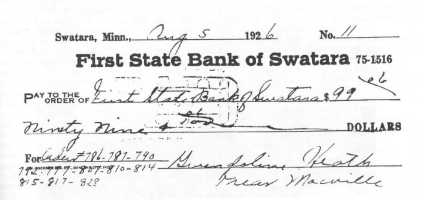
Bank Receipt - Courtesy of Aitkin
County Land Department
The bank seemed to operate well enough, but it did go through some
trying times. When the bank in Hill City failed due to "a run" on
deposits, there was concern that the Swatara bank might also fail.
Rumors spread that the Swatara bank might be hit by "a run." "William
Russell saved the bank. He ran the general store at Shovel Lake but he
also had an interest in the Swatara bank. He had a lot of money at the
Aitkin bank too. When the rumors of a run started, he withdrew
$10,000.00 from the Aitkin bank and brought it to Swatara where he piled
it up on the counter and said, 'We have plenty of money here!' That
seemed to impress the local residents, and we didn't have a run on the
bank." (Per interview with Robert Nicklason on November 14, 1995)
The Swatara State Bank was hit with a robbery in the summer of 1932.
(Aitkin Independent Age--September 2, 1932) "On examining what had
happened, it was found the robbers had gained entrance by a side door.
They had knocked off the dial and drove out the spindle, opening the
vault. They got to the safe and went to work on that. They knocked off
the dial to the safe, but had to drill to get to the works and in so
doing jammed the mechanism with shavings and were foiled in their
attempt to open it. They did get away with the change rack that had
about $100.00 still in it.....The Diobold Safe people sent out a German
locksmith but he was unable to open the safe....The next morning Frank
Olds was hired with his truck and a crew to haul the safe to the Diobold
Safe Company's service center in Minneapolis.(A Century of Pioneering
Pioneers, page 79)
The bank was bought out by the stockholders of the Shovel Lake State
Bank, and the bank at Shovel Lake was merged at Swatara. This bank
continued at Swatara until 1934, when it was moved to Remer where it is
in operation to this day. After the bank at Swatara had closed, it was
used as a saloon by Jule and Vida Albers. After that Carl and Ruth
Nelson ran it as a saloon for a while. (Per interview with Karin Bailey
on July 1, 1996)
In 1927, the "Swatara Imperial Band" was formed. George Robinson of Hill
City was the first band director. Later Mr. Julum of Aitkin directed the
group. Some of the band's members: Art and Earl Heath, Conrad Angermo,
Albert Hankins, Maymie Robinson, Ralph Randle, Raymond Cook, Louis
Sundsvold, Arthur Cartwright, Gale Gorsuch, Vivian Olds, Alice Robinson,
Charles Schoen, Frances Elliot, William Carr, Fred Biskey, Nellie
Robinson, Raymond Randle, Karen Nelson, Della Boys, Wendel Sundsvold,
George Robinson, Archie Sailor, Mastin Mount, John Knapp, Bernice Cook,
Denver Carr, George Arnold, Jack O'Konek, Clarence Arnold, Laird Nelson,
Bertha Kelly, Margaret, Mae, and Ed Snakenberg, Gladys Slyter, Mrs. J.
Gorsuch, Kathryn Boyd, Kenneth, Fred and Marchall Hankerson, Fannie
Angermo, George Franks, Dolly Carr, Bill Finch, Don and "Tubby" Franks,
and Fred Nelson who was the bass drummer. "The band members held Tuesday
evening their first business meeting since they organized fourteen
months ago. A. A. Heath was re-elected president, E. E. Heath
secretary-treasurer, Ed Mount, J. Biskey and J. Gorsuch directors.
During the last year the band has bought three metal clarinets, two alto
horns, one piccolo, and one baritone besides caps for the entire band.
The members feel well repaid for the years work." (Aitkin Age--December
8, 1928)
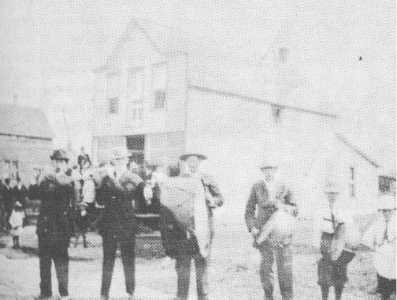
Swatara Town Band, July 4, 1913 -
Courtesy of Herman Nelson via Karen Bailey
The farmers of the area were experiencing hard times in the twenties and
so a local Farm Bureau chapter was formed in 1923. (Swatara Farm Bureau
minutes dated March 31,1923) Numerous meetings were held in an effort to
help the farmers improve production. It was also a way to get together
and have some socializing among friends and neighbors.
Occasionally, one of the farmers would have trouble keeping track of his
cows. "Ed Mount's cow decided to use the railroad track as a highway one
day last week. The fact that the east bound passenger was right behind
her made no difference to her for a time. Onlookers from a distance
enjoyed it more than Mr. Mount did as he was trying to catch up to the
cow. She finally jumped off and the train resumed its usual speed."
(Aitkin Republican--March 3, 1927
Turkey farming proved to be a successful venture for some. "Turkeys to
the amount of about 30,000 pounds were shipped from Swatara this year
according to T. E. Mount, Soo Line agent. Of these his reports show that
about 20,000 pounds were shipped in November and about 10,000 pounds in
December. This total equals the total amount produced in all of Aitkin
County in 1928. While exact figures were not available, Mr. Mount
indicated that most of the holiday birds were shipped in about equal
amounts to Minneapolis and Chicago markets, and a smaller amount going
to Philadelphia. Heaviest shippers were Mrs. E. R. McPheeters, John
Biskey and John O'Konek but numerous others added to the total."
(Swatara Sweepstakes--December 26, 1929)
The Soo Line Depot was not immune to attacks from the criminal element.
"Burglars broke their way into the railway station last Wednesday night
and rifled the till for its contents which totaled $8.09 according to T.
E. Mount, local agent. M. Martinson of Superior the special road
detective for the Soo Line Railway arrived on the scene and reported
from all indication that it was the work of a gang of criminals head
quartering in this section of the state. He stated that the thieves had
their plans well organized and knew the layout of the village and
station very well. From all the facts gathered, it is estimated that the
robbing took place about 1:30 a.m. The Board of Education was in session
at the schoolhouse until 1:15 a.m. when it was adjourned. Lewis D.
Peterson, the local school head, drove Mrs. Anna M. Nelson home and it
is thought that when he turned around at the Nelson home the lights of
his car was thrown upon the burglars for they had carried the till and
gum machine behind the potato warehouse to ransack. This evidently
frightened them as the pennies of the gum machine had been placed in the
till and left. About this same time Mrs. Pearl Heath heard a car come up
the road from the depot and turn toward Hill City going at terrific
speed. Mr. Peterson states that he saw the lights of the car as it sped
away and corroborated the statement of its unusual speed. The window was
broken and a jimmy used to pry it up. The same instrument was used in
opening the till. Nothing else was touched at all and no clues left to
aid in apprehending the burglars. The motive of the robbery is that the
burglar had known that the local depot had been receiving considerable
shipments due to road construction on the new T. H. 35 and local fall
shipping. They had anticipated that the cash receipts were kept in the
till. To their disappointment only a few dollars of loot was obtained.
This robbery was very similar to others which have occurred in the range
territory indicating that a group of gangsters are working this
territory. (Hill City News--September 19, 1929)
Efforts were made in the early thirties to help the new aviation
industry, by marking buildings with the names of towns. "A certificate
issued by the Daniel Guggenheim Fund and signed by Colonel Lindbergh has
been issued to Swatara in recognition for making is name visible to
aviators. This was done by painting the town name on the roof of the
bulk plant of the Standard Oil Co. As clerk of Macville Township, Roscoe
Reynolds has received the certificate and it is on display. A nation
wide campaign to obtain adequate marking of places so that they can be
identified from the air has been carried on by the Guggenheim Fund for
the promotion of aeronautics. The Standard Oil Co. has painted similar
signs in about 3,200 places. (Ibid, September 25, 1930)
The Hill City News tried to get interest in a local paper at Swatara. It
might have been spun off as an independent paper if the circulation had
been enough to warrant it, but sales weren't enough to keep it going.
The publication was called "The Swatara Sweepstake" with only nineteen
additions being published before it was ended. Much of the paper's news
centered on the activities taking place at the Swatara School. (Swatara
Sweepstake--January 16, 1930)
In 1930, the state decided to rebuild Highway 35. The new Highway 169
was relocated to the east of Swatara through Haypoint. This was a
significant blow to the community. Much business was lost due to the
fact that heavy traffic no longer moved through town. The stores and
other businesses suffered greatly. The depression was another heavy body
blow that hurt the town and the local economy. Business declined and
many people had a hard time making it during those years. The growth in
Swatara had halted, and a steady decline followed for years to come. In
an effort to take advantage of the new highway location, Frank Hutze
moved his place to Haypoint and started the Corner Store there.

Swatara Citizens, 1930
Front Row: Harvey Heath, Earl Heath, Grandpa Heath, Art Heath, Mrs.
Harvey Heath.
Back Row: Guendolyn (Mrs. Earl) Heath, ??, Grandma Heath, Nancy (Mrs.
Art) Heath.
Courtesy of Truman and Hazel Biskey
George Franks established a barber shop and pool hall at Swatara. John
Feathercard had a cream testing station. Another businessman was Joe
McQuiston. He had a small place and tested cream for the local farmers
after Feathercard gave it up. After Joe quit that business, cream was
tested at Trepanier's Store.
By 1930 or so, Frank Trepanier was ready to retire. He spent a few years
farming, worked some for the state and raised some fine gardens. In
1935, his son George and his son-in-law Leo Jewett decided that they
would try their hand at the grocery business. The Trepanier-Jewett Store
had some tough years and eventually Leo got out of it and George kept on
with the business for many years.
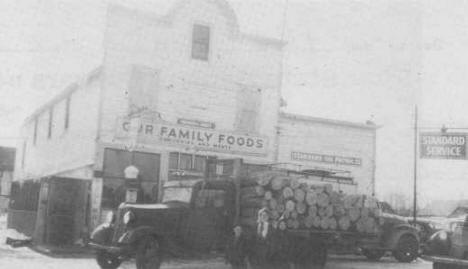
Trepanier & Jewett Store - Courtesy of
Betty Trepanier

Inside the Trepanier & Jewett Store
Pictured: Leo Jewett, Harvey Trepanier, Clyde Stansbury, Evelyn
Stansbury
Courtesy of Evelyn Hilton
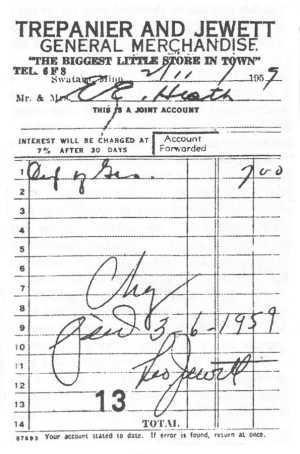
Trepanier and Jewett Receipt -
Courtesy Ken Gobel Frank Zealand had been a deputy sheriff for a
number of years. In 1934, he felt the time was right to run for sheriff
of Aitkin County. However, he lost to C. S. Lind. The vote totals were:
C. F. Lind-2084, Ned Price-1830, Frank Zealand-733, Henry Riley-336, and
Emil Erlandson-311. (Aitkin Independent Age--June 22, 1934)
In the summer of 1938, the Heath Brothers Store was robbed. As the
Swatara Bank had moved before this, the Heath Brothers cashed local
checks and had quite a sum on hand to accommodate its customers. The
robbers were called "The Cream Can Burglars." They got this name from
how they carried out each job. "Their pattern was to borrow a cream can
or two from some produce station and fill it with water which would be
used for cooling the cutting torch used for cutting away the combination
off the safe and they always left (as their trademark) the cream can."
(A Century of Pioneering Pioneers, page 65) The safe had been opened and
quite an undetermined sum removed.
Another robbery was held at Frank Hutze's store at Haypoint. "Two men
entered the store and at the point of a gun (they) removed a slot
machine and took off south....These robbers were never apprehended."
(Ibid, page 65)
Since the Swatara Bank was gone, the Heath Brothers started up the
business of loaning money. Sometimes they would buy the debts from
various places for the local people and work with them in retiring the
debts. They were basically a collection agency. (Correspondence of
Montgomery Ward dated November 1, 1935)
Pat McGlade was the first justice of the peace for Swatara (Macville
Township), and served until Art Heath became the justice in the
twenties. The local justice had some authority in that position and
actually held court over local matters of dispute. In one such case, Art
Heath presided in the case of the Town of White Elk vs. S. H. Yoemans
"Plaintiff, by Ray Ramey, Chairman of the Town Board, filed affidavit in
Replevin, duly verified, stating that one telephone complete except
batteries, of its personal property is at this time wrongfully detained
from it by said Defendant, and that it is entitled to immediate
possession, thereof, (Replevin) and that the value of said property is
twenty-three dollars. Bond in Replevin in double the value of the
property approved and filed. Writ of Replevin issued, returnable at my
office in the Town of Macville in said county on the 10th day of
October, 1927, at 9:00 o'clock a.m. and delivered to deputy Sheriff
Frank E. Zealand for service." (In Justice's Court, Town of Macville,
Aitkin County Land Dept. records dated September 30, 1927)
Recreation was not absent during the depression years. The Remer Record
Newspaper relates: "The Circus at Swatara Thursday drew quite a large
number of people from Shovel Lake and vicinity. " (Remer Record) The
senior class of Remer held a three act play called "Always in Trouble'
in Heath's Hall. The admission was twenty cents.
Macville Township was active in many affairs over the years. During the
depression, the town board worked with the W. P. A. program in helping
men to do productive work. "The board resolved that they would give
$15.00 towards a warming shack for the W. P. A. crew which is now
working on roads in the Town of Macville. (Macville Town minutes dated
November 12 1938) The township appointed Art Heath as the township
custodian and sexton of the Macville Cemetery on March 21, 1942. (Ibid,
March 21, 1942) That same year saw the board made up of Everett Ramey,
Leo Jewett, and William Schindele. Jessie Ramey was the clerk with
Everett Ramey as the constable and Art Heath became the justice. They
also granted Jack Jam a 3-2 beer license for his business. Another
license was given that summer. "Motion made....To grant permission to
Frank Trepanier to obtain a 3-2 beer license, as Julius Albers has gone
out of business leaving an opening for a beer parlor, (motion) carried."
(Ibid, dated June 22, 1942)
Buck Gillson had a crate factory at Swatara in the forties. "He used to
go around the countryside and buy timber or lumber and haul it to the
cities. He started a crate factory in the old blacksmith shop. He sold
the crates to some guy in the cities which were used for shipping
freezers and other appliances. He later moved his operation into Herman
Nelson's garage and even expanded into the old bank building. Something
went wrong though, and he went out of business." (Interview with Kenny
Goble on June 18, 1996)
In addition to his repair work, Herman Nelson had dances at his garage.
"The dance given by the Nelson Brothers in their new garage building was
a great success, and was well attended on Saturday night." (Aitkin
Republican--May 10, 1934) Herman ran his auto repair garage until about
1942. He had torn down Heath's Big Store in 1939 and used the lumber to
build a house in Excelsior, MN. Eventually, he ended up moving to
Milaca, MN.
On June 30, 1951, Harvey Trepanier assumed the job of postmaster at
Swatara. Harvey showed great dedication to the community and remained
postmaster until September 30, 1983. There were a few others who served
after Harvey and now the mail comes from Hill City. (Per interview with
Betty Trepanier on September 30, 1996)
On September 5, 1958, the Soo Line Railroad called for and got a hearing
to ask for a complete discontinuance of agency service at Swatara. The
Railroad and Warehouse Commission did not allow the request, and yet on
May 16, 1959, the Soo Line took off trains numbered 64 and 65 which
ended passenger and mail service to Swatara. (A Century of Pioneering
Pioneers, page 64) Cars were still left at the side track for pulp
loading and some freight could still be delivered by train until on
March 3, 1972, when the Soo Line Depot was closed for good.
On February 24, 1955 the Swatara Community Club was formed. There were
about forty people present and they elected the following officers.
Robert Bailey as president, Donald Hall as vice president, and Harvey
Trepanier as secretary-treasurer. A number of fund-raisers were held for
construction of a community hall. In 1961, construction began and on May
27, 1962 a dedication of the new hall was held. (Ibid, page 115) Since
that time many events such as weddings, showers, dances and other
gatherings were held there.
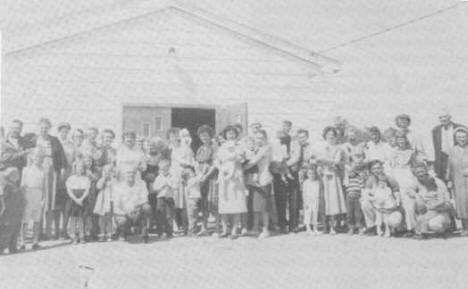
Swatara Community Hall Dedication, 1961 -
Courtesy of Truman and Hazel Biskey
A cemetery association was set up to keep the Macville Cemetery in good
order. "An organization known as the Macville Cemetery Association was
formed at a special meeting at the community hall on May 16, 1963. Mrs.
Verona Fossen was elected president, Kenneth O'Konek secretary and Mrs.
Hazel Biskey, Treasurer. It was decided that donations in addition to
the annual fee would be solicited for the first year in order to get the
cemetery in good shape." (Aitkin Independent Age--May 16, 1963) The
association continues to this day, and works in concert with the
township to keep the cemetery in good condition.
A change occurred in the ownership of the Swatara Café in 1964. "Mr and
Mrs. Harry Huntly have purchased the Swatara café....Mr. and Mrs. Mervin
Fossen former owners, will move to their new location on Highway 169
(the property formerly owned by Mrs. Hayes). The community will miss the
Fossens but does wish them continued success at the new location."
(Ibid, April 22, 1964)
Swatara spent the rest of the sixties in relative anonymity. This
situation changed dramatically in the early seventies when Swatara and
the surrounding townships were selected to be the home of the Minnesota
Experimental City (MXC). The effort began in 1965, when Dr. Athelstan
Spilhaus called for a full scale city experiment. In a comic strip drawn
by Splihaus, named "Our New Age," he first put forth the concept of an
experimental city. (Duluth News Tribune--February 25, 1973) A number of
people from business, industry, government, and the academic community
responded favorably. To them, the city should be more than a physical
experiment. It would demonstrate the application of developing
technologies to our service delivery problems. It would be a crucible in
which to try out some of the new ways of life made possible by the
current economy and technology. They were looking for ways to achieve
social and political objectives and devising institutions for the
requirements of a new era.
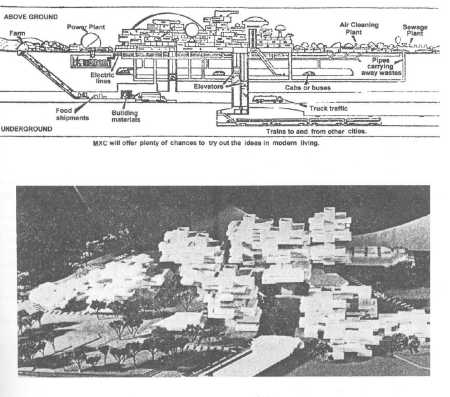
Top: MXC Plan
Courtesy of Mr. and Mrs. Ken McNeil
Bottom: A Proposed Model of the Experimental City
Courtesy of Minneapolis Star Tribune
The plan was to build a city of 250,000 people in a rural area of the
state, free of the influences of current cities. The whole experiment
was to build a city that would use new technologies and would design new
ways to operate that would be less wasteful and harmful to the
environment. There was too much urban sprawl taking place, and resources
were being wasted. The schools were felt to be failing in their job of
providing good education to the children. Pollution was everywhere and
getting worse. It was felt that such a city had to be at least one
hundred miles from any existing urban area in order to be free from that
urban area's influence.
In the closing hours of the 1969 legislature, the Minnesota House and
Senate authorized the study of the Minnesota Experimental City with its
needs and requirements. A joint committee was set up between the House
and Senate to study the city concept. A national committee was
established that would act as a steering committee. It consisted of such
notable figures as: Otto Silha, Gaylord Anderson, Dr. James Cain, Hale
Champion, Max Feldman, Rita Hauser, Walter Heller, Martin Marty, Malcolm
Moos, Joseph Pechman, Roger Revelle, General B. A. Schriever, Muriel
Snowden, Wayne Thompson, Walter Vivrett, William Wheaton, Walter
Beattie, Harrison Brown, Arthur Flemming, R. Buckminster Fuller, Harvey
Perloff, O. Meridith Wilson, Whitney Young and Athelstan Spilhaus. There
were five phases planned in all, each with increasing dollar commitments
needed.
In 1971, the legislature authorized the creation of an eleven member MXC
Authority which was empowered to move into a second phase of planning.
The members of the authority were: E. E. Eieber, Archie Chelseth, Mrs.
Bridget Coleman, Carl Herbert, James Hetland, Todd Lefko, Mrs. Hella
Mears, John Neumeier, Otto Silha, Mrs. Marlys Soderberg and Wayne
Thompson. Ex Officio members were Robert Herbst-Commissioner of the D.
N. R., Grant Merritt-Executive Director Minnesota Pollution Control
Agency, Gerald Christenson- Director of the State Planning Agency and
Eugene O'Brien. (MXC , Preliminary Report on site selection
recommendations, dated December 1972) James Alcott became the executive
director for the Authority. The Authority was charged with planning the
various needs of the city and to select a site for it. Wayne Thompson,
vice president of Dayton-Hudson, chaired the site selection committee.
(Per letter from Otto Silha dated October 4, 1996) A federal grant of
$250,000.00 was secured with money coming in from the private sector.
Dayton's Northern States Power, Pillsbury, Honeywell, and the
Minneapolis Star and Tribune joined with five big state foundations and
the American Gas Association with donations of about $670,000.00.
Studies were carried on by the Authority with the help of the University
of Minnesota, North Star Research and Development Inc. and other
institutions. Ford Motor Company spent $300,000.00 of their own money on
the transportation study alone. They were looking for new kinds of cars,
how to move them, and whether a monorail would be feasible. Other
studies were conducted on urban design, telecommunications, climate,
education, healthcare, and energy and waste water treatment.
Various criteria were used in the siting process. After a number of
sites were looked at, two were selected. One was near Evansville in
Douglas County and was called the "Lake Region" site. The "Pine Moraine"
site was at Swatara and included much of northwestern Aitkin County and
part of northeastern Cass County. The concept of this totally planned
city was to have an urban core surrounded by less densely crowded areas
that would serve as residential plots. A buffer area would surround the
entire city for "green space" and would hopefully prevent the city from
entering the usual patterns of urban sprawl. The site consisted of about
75,000 acres.
The idea of experimental cities had its advocates all over the country.
Other states were considering the construction of such cities and the
state of Virginia was one of those in the forefront of this effort. In
Minnesota, the pre-planned city had already begun with efforts such as
the "Jonathan" development. Jonathan, which didn't meet the criteria of
"being away" so it could develop with out the influence of a large metro
area, was eventually absorbed by the city of Chaska.
The Aitkin County Board voted 5-0 in favor of MXC. They felt it would be
good for the county, as the city would create jobs for the young people
and help keep them in the area. The mood was mixed in the Swatara-Hill
City area. Many people were for the city, at least at first. There were
a few against the concept, and they kept up their efforts and got more
support as time went on. They simply could not see how a city of 250,000
people could be built without destroying the current environment.
A group called "Save Our Northland" was formed by some of the people in
opposition to MXC. Its president, was Dale LaRoque from Grand Rapids.
Hearings were held in the area while the tension increased. In the dead
of winter in January of 1973, a group of opposition citizens went on a
marathon walk from Swatara to St. Paul to protest MXC. Letters to the
editor started flowing in from all over with some calling the city a
"Trojan Horse." In the 1973 legislature, the hearings were packed by
those in opposition. The Minnesota Pollution Control Board voted 8-1 on
a resolution against MXC. The resolution stated that construction of new
urban complexes "....does not seem to be a prudent policy." Support
withered as the legislators started to get uncomfortable with the
negative attention they were getting. Committee after committee voted to
stop the process. The request of the Authority was for another
$300,000.00 to move ahead with land acquisition and further planning
efforts for MXC. In the end, no money was appropriated by the
legislature, and on June 30, 1973, the MXC effort died.
Did MXC die from the growing opposition or was it the growing cost of
the project? A report to the legislature stated that the full cost of
building the city would probably be in the $10 to $15 billion dollar
range. (MXC, Comprehensive Planning for a Quality Urban Environment by
James R. Prescott dated January 30, 1969, page 2) They said that amount
would be spent anyway so why not do it right? Perhaps some credibility
was lost when the concept of a dome was proposed to cover part or all of
the city. The Nixon administration was already making cutbacks and the
country was moving into a more conservative mode. The "Great Society"
programs were coming to an end. It seemed the legislature was more
concerned about the financing of the new "Metrodome" than they were in
building a city. Or perhaps the energy crisis of 1973 distracted the
country and made financing the city problematic. In any event, the
effort failed, and Swatara was left to its own resources. A new
experimental city is now taking place in Florida. Disney is building its
city known as "Celebration." (Newsweek--May 15, 1995, page 43) Whether
that city will succeed, only time will tell.
After the excitement over MXC ended, Swatara settled back into its
normal pattern of existence and the area continued on. People found work
either in farming, logging, or commuting to towns such as Grand Rapids
where employment was available.
In the early seventies, the enrollment at the Swatara School declined to
a point at which the district felt obliged to merge with Hill City.
After that, Hill City sent additional children to Swatara and used it as
an elementary school for much of the district. When the new Hill City
School was built in 1983, (Interview with Grace Trepanier on September
30, 1996) the Swatara School was closed.
On April 19, 1985, the last train rode over the Soo Line. The depot
burned to the ground in 1987. (Interview with Betty Trepanier on
September 30, 1996) The tracks were torn up and the right of way is now
owned by Aitkin County. It is used as a snowmobile trail which has
gained in popularity in recent years.
Many people in the Swatara area farmed over the years or worked in the
woods. If you were lucky, you might have a job at Blandin Paper Company
or some other business for additional income. Raymond Jewett was a
successful logger for a number of years, but a sad event occurred when
Ray was killed in an automobile accident. His wife Joan still carries
on. Any community feels the loss when such fine people meet tragedy.
Life goes on. Swatara still survives, if at a slower pace than in its
past. It is a quiet, peaceful community and the folks are friendly. The
Swatara ladies have a social club known as the "Royal Neighbors." They
have met for many years and continue to meet to this day. Dorothy Biskey
has been their representative for a number of years. (Interview with
Karin Bailey on July 1, 1996)
A celebration is held on a weekend near the Fourth of July in which a
community gathering takes place. An "old timers' baseball game is played
on the "Home Field," and the town team recently made it to the state
tournament. While the "Skeeters" fell short of the title, they did show
that they were a quality club. (Interview with Bob Passig on March 10,
1997) Swatara continues on, and its people will always call it home.
|
|



